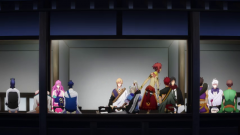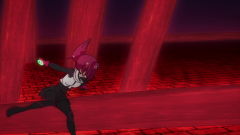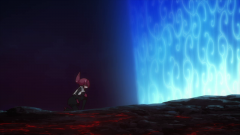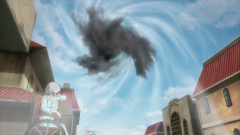Namu Amida Butsu!: Rendai Utena
Short Synopsis: Pretty boys who are deities and their jobs is to destroy negative energy from human.
Mario’s review:
When will this hot boys trend die down? Rendai Utena (not to be confused with Ikuhara’s Utena. That’s an insult!) spends 80% of its energy to introduce dozen boys with colorful designs who happen to be deities. What do they do in this entire episode? Cleaning the house, buying some goddamn milk and eating dessert together. The rest of its energy it addresses its main concept: they’re here to destroy vices, negative force within each human. I mean, dessert is nice and all but that’s the only entertaining part I can take out from this episode. The production is below par, the characters are nothing original and the concept isn’t that engaging or interesting. It doesn’t have anything offensively terrible, but at the same time it doesn’t leave much impact to me whatsoever.
Potential: 0%
RobiHachi
Short Synopsis: A down-on-his-luck freelance journalist flees Earth to escape a loan shark, but accidentally brings along one of his debt collectors.
Wooper’s review:
RobiHachi is Space Dandy by way of last year’s Double Decker, with 10% of the humor and 0% of the style. It sports a colorful sci-fi setting with flying cars and bustling city life, but only takes advantage of it once or twice in this premiere (the scene where Robby gets caught in an alien street crossing comes to mind). Apart from those rare moments of inspiration, it’s only a mildly amusing and below average-looking buddy comedy. Main character Robby takes life as it comes, while Hachi is obsessed with experiencing new things, and these traits envelop their entire personalities, rather than informing them. As a result, there’s a lot of bickering between the two, including a moment where Robby gives a lecture on smelling the roses, and a smooth sax solo starts playing as though he were Onizuka from GTO. Speaking of music, the second half of this episode takes every opportunity to cram boilerplate 80s rock into the background, even when characters are just talking to one another. I can only assume this choice was made to distract from the series’ limited animation, which punches below the standard of modern TV anime. Even Robby’s insulting rabbit butler is only good for a couple chuckles before the whole show collapses under its own weightlessness. Unless you’re really into space adventure/comedies, give this one a pass.
Potential: 20%
Mario’s review:
Hmmm, even the character design of Hatchi reminds me a great deal of last year’s Double Decker and the plot is a mashup of shows from the past (Space Dandy, Cowboy Bebop come to mind), so right at the first round the originality is already out of the window. Then the production isn’t something that I normally recommend, given it doesn’t impress me in any way. Furthermore, while I’d say the mains’ interaction is solid (hence the score), I don’t care much for either Robby and Hatchi individually. The brief callback to Robby’s misfortunate events is funny on paper, but when they display it on-screen, it falls flat. This premiere runs mostly as a prologue to the adventures between this duo as they travelling through planets, so I’d say that next episode is where the show showcases its true color. One important thing that the premiere fails to do, however, is that for a show that has “cool” factor written all over, it doesn’t offer half of the “cool” vibe it aims to achieve.
Potential: 20%
Gunjou no Magmel
Short Synopsis: A relief worker trained in supernatural combat travels to a mysterious continent to find a client’s brother.
Mario’s review:
Magmel is based on a Chinese manhua and it pains me to say that anime medium doesn’t have a good track with Chinese material. But I have middling expectation for this one based entirely one the first manga chapter that I read, with was a decent fun. Turns out that this first episodes material isn’t the same with the first chapter, but I’m still pleasant surprised on how much I enjoy Magmel so far. Its biggest strength right now is its setting that is both dangerous and inviting at the same time. The setting reminds me a bit of Made in Abyss, which is pretty decent praise in my book. It also succeeds on providing the sense of adventuring, of discover new area and monsters. This episode’s story works well as a standalone story and as a good introduction as how twisty this new continent can be. So far, I like the main characters well enough, and even the side characters have some legit moments there. The fact that it’s made by Studio Pierrot means that they can pad out this material with fillers and squeeze the most out of this show’s juice, but as far as “intriguing” goes you bet I am.
Potential: 50%
Wooper’s review:
The first thing I have to mention about this show is the background art, which is verdant and lush. It was really important that the series nail this aspect of its production, since it’s set largely on an unexplored continent where thousands of new species are lurking. That kind of setting should be as vivid on screen as it is in concept, and here Gunjou no Magmel succeeds. The second thing I have to mention is that everything else about the series bored me. The gigantic flashback to a one-off character’s backstory near the start killed its initial momentum, and his cluelessness until the moment of his death made him frustrating to watch. Main character Inyou’s stoicism isn’t a bad foundation for his character, and his willingness to kill a man he’d promised to save was appreciated (as opposed to the righteousness of most shounen protags). But he didn’t hold my attention despite his position in the dead center of the story, perhaps because of his overwhelming strength. The relationship between him and his robot-piloting maid wasn’t even deep enough to get my toes wet, either. I’ll admit that these are a lot of criticisms for a shounen series with a simple core concept. It ought to be judged largely on the strength and viability of that premise, and I think there’s lots of room for Magmel to do its thing in future episodes. That “thing” ought to look a lot different from this premiere, though.
Potential: 30%
















































